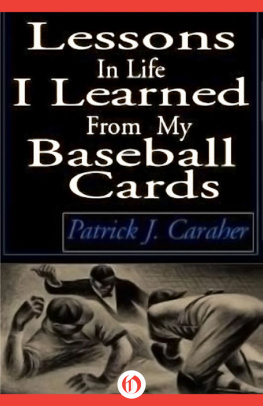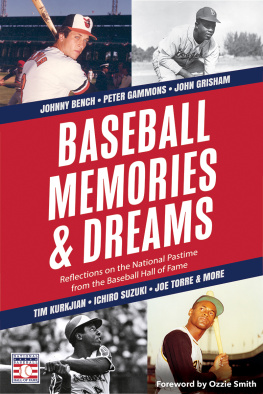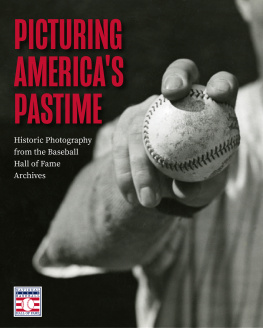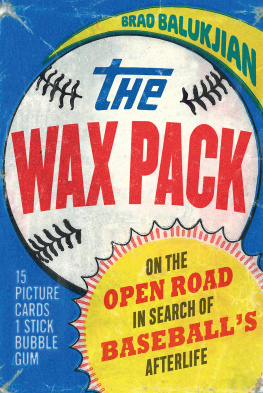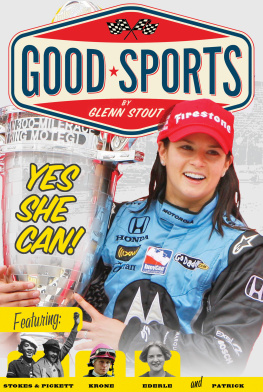All rights reserved, including without limitation the right to reproduce this ebook or any portion thereof in any form or by any means, whether electronic or mechanical, now known or hereinafter invented, without the express written permission of the publisher.
Copyright 2002 by Patrick J. Caraher
Cover design by Open Road Integrated Media
ISBN 978-1-4976-2609-6
This edition published in 2014 by Open Road Integrated Media, Inc.
345 Hudson Street
New York, NY 10014
www.openroadmedia.com


Open Road Integrated Media is a digital publisher and multimedia content company. Open Road creates connections between authors and their audiences by marketing its ebooks through a new proprietary online platform, which uses premium video content and social media.
Videos, Archival Documents, and New Releases
Sign up for the Open Road Media newsletter and get news delivered straight to your inbox.
Sign up now at
www.openroadmedia.com/newsletters
FIND OUT MORE AT
WWW.OPENROADMEDIA.COM
FOLLOW US:
@openroadmedia and
Facebook.com/OpenRoadMedia
Lessons in My Life I Learned From My Baseball Cards
Patrick J. Caraher

To Steven, Bridget and Rick.
May the World be your Field of Dreams.
Introduction
Every Christmas I give one of my nephews a card from my baseball card collection. And every year, whether spoken out loud or just with his eyes, he asks the same question.
What's it worth?
The answer always comes as a struggle because when talking about the value of my baseball cards we speak two different languages. He wants to know the market price for the card and, while sensitive to the business aspect of baseball cards, that is not what I consider the gift to be.
There is no quick answer to this question and I have worked to come up with the best response. Now, let me tell you what these cards are worth...
Chapter 1
1974 Hank Aaron
Slow and steady wins the race.
-Aesop, The Hare and the Tortoise
Following in the footsteps of my two older brothers, I wanted to do whatever they did. Upon reaching age seven I was finally old enough to get an allowance of 50 cents and walk with them to the convenience store. At the time, candy bars cost only 5 cents a piece and 50 cents seemed like a small fortune. I found myself making the same purchases as my brothers and along with candy and soda, they also purchased baseball cards. I didn't know what to do with these baseball cards but they made me feel older, like my brothers.
After taking these baseball cards home I would play imaginary baseball games with them, organizing them by position and then setting them up on the living room floor to create my own make-believe infield. However, these baseball cards did not enjoy a long life. Most met their demise when they were attached to the spokes of my bicycle.
Over time, as my interest in baseball grew, I came to see cards as more than just a picture and statistics to be looked at and thrown away. In the light of my budding enthusiasm for Major League Baseball, cards now seemed like a tangible part of that excitement. Baseball cards somehow connected me with the Major Leagues and their value greatly increased in my eyes. Old cards were now saved in shoe boxes rather than destroyed. I had become a collector.
I approached the 1974 season with an increased zeal. With money now being earned from a paper route, more packs than ever before were purchased. My young appetite appeared insatiable yet it remained raw and unfocused. Then a goal began forming in my mind. As they do today, some packs of baseball cards contained checklists for the cards within the set. I joyously checked off the box on the checklist for each new card that I obtained. As my excitement for filling out these checklists grew, there was only one thing left to do; attempt to collect every card made for the yeara complete set.
Collecting a complete set of cards was no simple task because I needed at least one of every card. No card could be missing. While my primary source of cards was purchasing new packs at the local convenience store, I could not rely on them alone. Part of being an accomplished baseball card collector meant having a network of peers amongst which one can trade. Everyone traded their duplicate cards (known as doubles") with the doubles of other collectors. Trading cards was not typically a one-for-one matter. Some cards were valued more highly than others and it was advantageous to get doubles of these more valuable cards. So, when buying a pack of cards, if the cards you got couldn't plug a gap you may at least have been able to get some good trading material.
The premier card of the 1974 set was #1, Hank Aaron. The reason for all the excitement over Hank Aaron in 1974 was that he had just broken Babe Ruth's all-time homerun record. Homerun hitters always attract attention and for what seemed to be an eternity, Babe Ruth reigned as King of all homerun hitters. Now, Hank Aaron had captured that crown and a new era in baseball was beginning. His baseball card captured a part of that glory.
Every time I opened a new pack I hoped to find one of his cards. With 660 cards in the whole set and only ten cards to a pack, it was a long shot. With a Hank Aaron you struck gold because even if you already had it, his card traded quite well.
There exists a special excitement when opening a new pack of baseball cardsthe excitement of the unknown. Will I get some great cards? Will I get a bunch of stuff that I already have in triplicate? I still occasionally purchase packs of cards and feel vestiges of that excitement. Wondering what surprises are in store, subconsciously I think I am still looking for a 1974 Hank Aaron.
Hank Aaron's 1974 card was not his only valuable one. His cards from previous years were also good trading material but in 1974 they were no longer available at the store. Because Hank Aaron's cards were so valuable, I thought that it would be worthwhile to scout out the homerun kings of the future. By getting an early start on collecting these stars I would have valuable trading material in the future. So, I studied the statistics on the back of his card in order to learn how he got to the top. With a little luck this knowledge might be used to find the next Hank Aaron.
By the end of the 1973 season, after playing for 20 years, Hank Aaron had accumulated 713 homeruns. Expecting to see some big years, I was surprised to learn that he never hit 50 homeruns in a single season and most of his career he hit in the 30's or 40's. He even had 4 seasons with less than 30 homeruns. This was hard to believe because I expected that a player would have to lead the league in homeruns most of the time in order to become the all-time homerun king. That he didn't always lead the league came as a surprise but, the total of all of his seasons added up to an impressive number. This great lifetime accomplishment was achieved in small steps.
I assumed that to break Hank Aaron's record all one would have to do was duplicate his career. Hank Aaron did not hit many homeruns at the beginning of his career. In fact, he hit only 13 homeruns in his rookie season. So, I figured that any player who hit close to 13 homeruns during his rookie year had a chance to repeat Aaron's career. Granted, there is a fine line between prediction and wishful thinking, but when Brian Downing of my beloved White Sox hit 10 homeruns during his 1974 rookie season I predicted that he could match Hank Aaron's career. Of course Brian Downing never even approached Hank Aaron's homerun record and only once did I make the mistake of vocalizing this theory.
Next page
